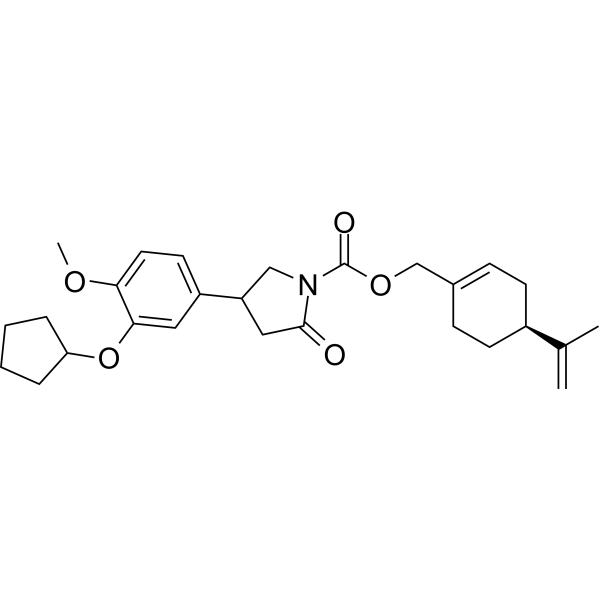Physicochemical Properties
| Molecular Formula | C27H35NO5 |
| Molecular Weight | 453.57 |
| Exact Mass | 453.251 |
| CAS # | 1361198-80-2 |
| PubChem CID | 56846913 |
| Appearance | Colorless to off-white ointment |
| LogP | 5.1 |
| Hydrogen Bond Donor Count | 0 |
| Hydrogen Bond Acceptor Count | 5 |
| Rotatable Bond Count | 8 |
| Heavy Atom Count | 33 |
| Complexity | 756 |
| Defined Atom Stereocenter Count | 1 |
| SMILES | COC1C=CC(C2CN(C(=O)OCC3CC[C@H](C(=C)C)CC=3)C(=O)C2)=CC=1OC1CCCC1 |
| InChi Key | JDWAOYHBJSFPSD-PSDZMVHGSA-N |
| InChi Code | InChI=1S/C27H35NO5/c1-18(2)20-10-8-19(9-11-20)17-32-27(30)28-16-22(15-26(28)29)21-12-13-24(31-3)25(14-21)33-23-6-4-5-7-23/h8,12-14,20,22-23H,1,4-7,9-11,15-17H2,2-3H3/t20-,22?/m1/s1 |
| Chemical Name | [(4S)-4-prop-1-en-2-ylcyclohexen-1-yl]methyl 4-(3-cyclopentyloxy-4-methoxyphenyl)-2-oxopyrrolidine-1-carboxylate |
| HS Tariff Code | 2934.99.9001 |
| Storage |
Powder-20°C 3 years 4°C 2 years In solvent -80°C 6 months -20°C 1 month |
| Shipping Condition | Room temperature (This product is stable at ambient temperature for a few days during ordinary shipping and time spent in Customs) |
Biological Activity
| References |
[1].Inhibition of autophagy and induction of glioblastoma cell death by NEO214, a perillyl alcohol-rolipram conjugate. Autophagy. 2023 Dec;19(12):3169-3188. |
Solubility Data
| Solubility (In Vitro) | DMSO :~100 mg/mL (~220.47 mM; with sonication) |
| Solubility (In Vivo) |
Solubility in Formulation 1: 2.5 mg/mL (5.51 mM) in 10% DMSO + 40% PEG300 + 5% Tween-80 + 45% Saline (add these co-solvents sequentially from left to right, and one by one),clear solution; with ultrasonication. For example, if 1 mL of working solution is to be prepared,you can add 100 μL of 25.0 mg/mL clear DMSO stock solution and add it to 400 μL PEG300 and mix well. Then add 50 μL Tween-80 to the above system and mix well. Then continue to add 450 μL of physiological saline to make up to 1 mL. Preparation of saline: Dissolve 0.9 g of sodium chloride in 100 mL ddH₂ O to obtain a clear solution. Solubility in Formulation 2: 2.5 mg/mL (5.51 mM) in 10% DMSO + 90% (20% SBE-β-CD in Saline) (add these co-solvents sequentially from left to right, and one by one),clear solution; with ultrasonication. For example, if 1 mL of working solution is to be prepared,you can add 100 μL of 25.0 mg/mL clear DMSO stock solution and add it to 900 μL of 20% SBE-β-CD saline solution and mix well. Preparation of 20% SBE-β-CD in Saline (4°C,1 week): Dissolve 2 g SBE-β-CD in 10 mL saline to obtain a clear solution. Solubility in Formulation 3: 2.5 mg/mL (5.51 mM) in 10% DMSO + 90% Corn Oil (add these co-solvents sequentially from left to right, and one by one),clear solution; with ultrasonication. For example, if 1 mL of working solution is to be prepared,you can add 100 μL of 25.0 mg/mL clear DMSO stock solution and add it to 900 μL corn oil and mix well. (Please use freshly prepared in vivo formulations for optimal results.) |
| Preparing Stock Solutions | 1 mg | 5 mg | 10 mg | |
| 1 mM | 2.2047 mL | 11.0237 mL | 22.0473 mL | |
| 5 mM | 0.4409 mL | 2.2047 mL | 4.4095 mL | |
| 10 mM | 0.2205 mL | 1.1024 mL | 2.2047 mL |
